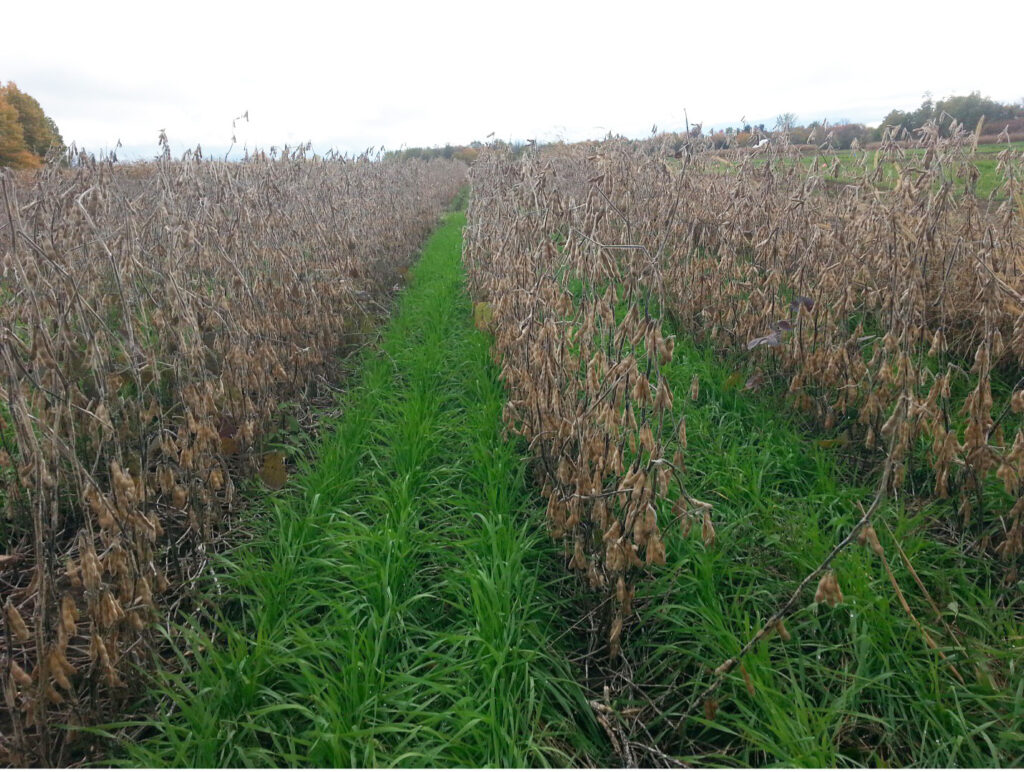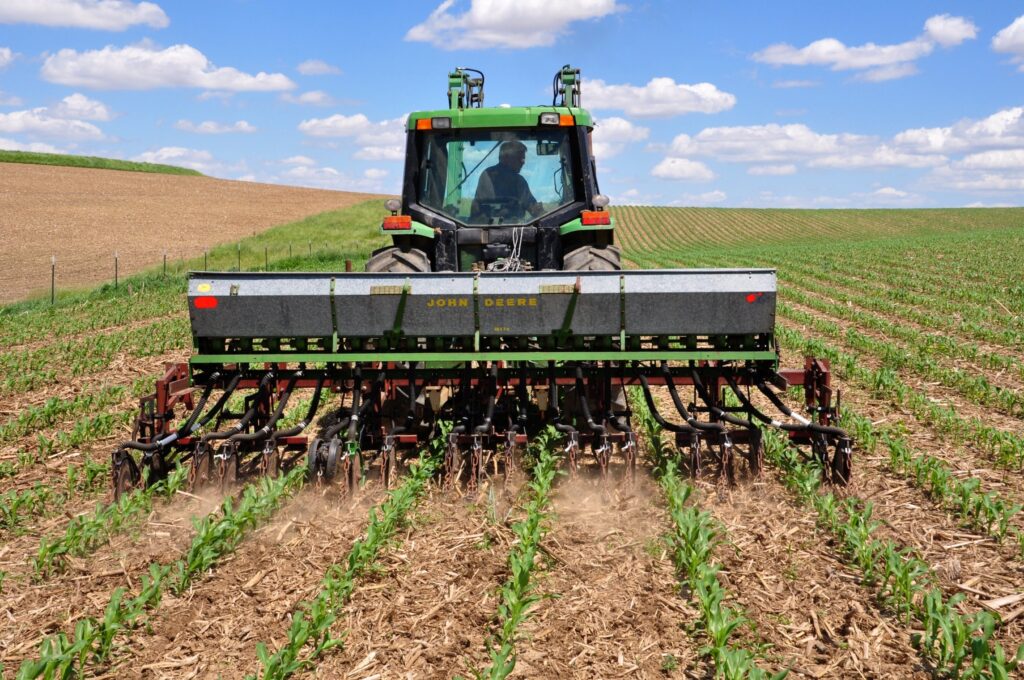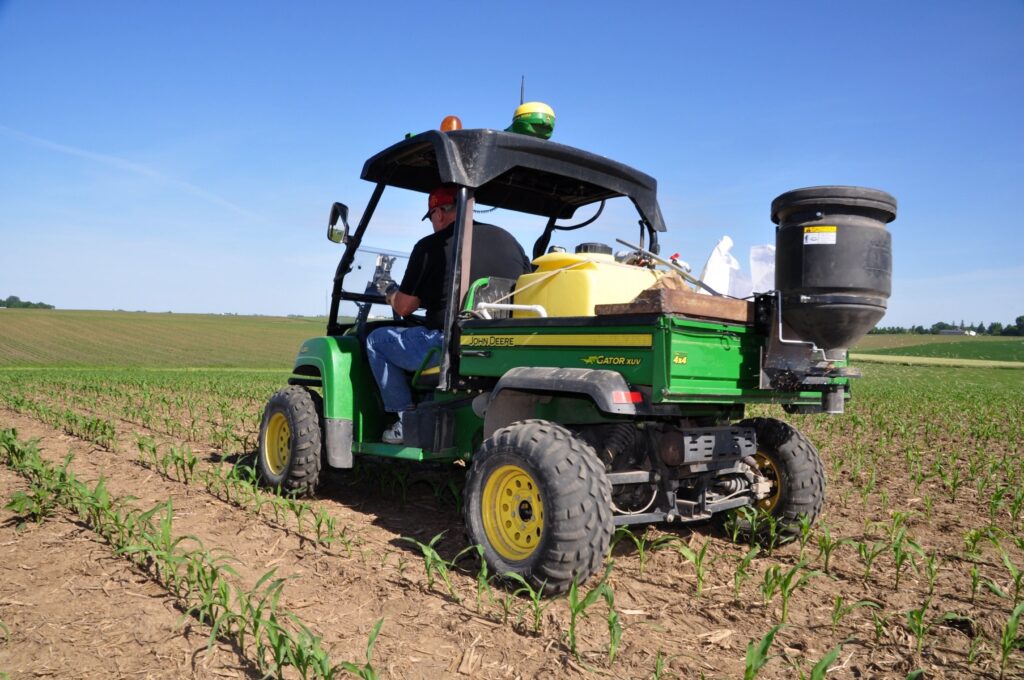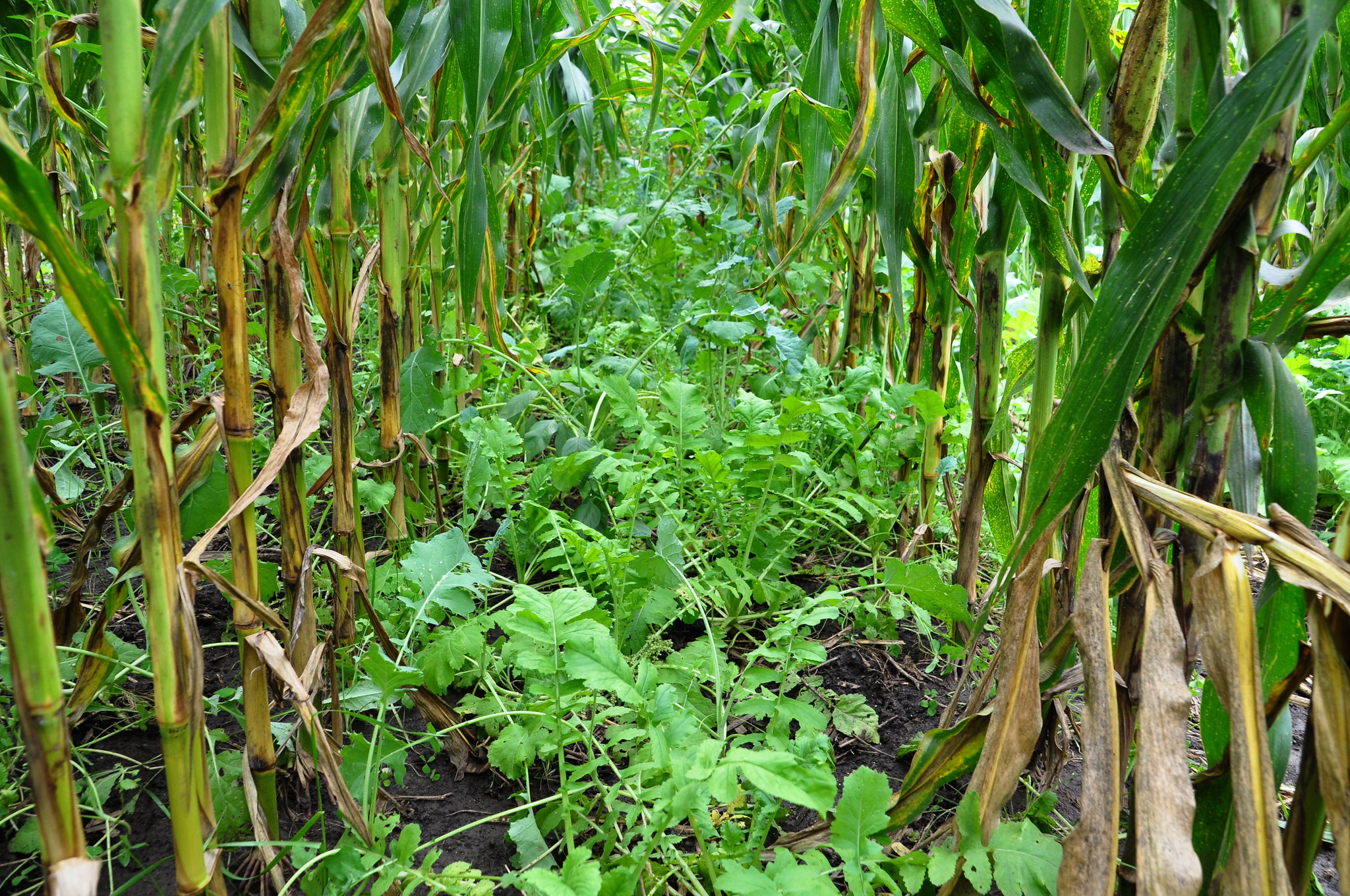Interseeding is the practice of planting a secondary crop into an already growing main crop without disturbing it. It helps improve soil health, suppress weeds, and retain moisture while making the most of available space. Think of it as giving your fields a helpful sidekick that works alongside your primary crop to boost long-term sustainability!
Note: The term interseeding is also used in pasture management and renovation, where a legume or more productive pasture grass is introduced into an existing pasture sod. This article focuses on interseeding as planting secondary crops into a primary planting, not rejuvenating pastures.
The Resurgence of Interseeding
Interseeding isn’t a new practice — it has been used in farming for centuries but is regaining popularity again as producers integrate sustainable practices. Traditional agricultural systems, including Indigenous and early agrarian societies, practiced interseeding as part of polyculture and companion planting methods to maximize land use and maintain soil fertility.
- Ancient Practices: Indigenous groups in the Americas used interseeding in the “Three Sisters” system, where corn, beans, and squash were grown together to improve soil health and productivity.
- 18th-19th Century: European and early American farmers interseeded clover and other legumes into grain fields to enhance soil nitrogen and provide livestock forage.
- 20th Century: With the rise of industrialized agriculture, interseeding declined due to increased reliance on monocultures and synthetic fertilizers.
- 21st Century: Interseeding has made a resurgence with the push for regenerative and no-till farming, where it is used to improve soil health, reduce inputs, and increase sustainability.
Modern techniques have evolved with advancements in equipment and precision planting methods, allowing for better integration into farming systems.
Benefits of Interseeding
Soil Health Improvement
Healthy soil is the foundation of productive agriculture, and interseeding contributes significantly by:
- Increasing Organic Matter: Interseeded cover crops add biomass to the soil when decomposing, improving soil structure, water retention, and nutrient availability.
- Enhancing Microbial Activity: The diverse root systems of interseeded crops create a more favorable environment for beneficial soil microbes, which aid in nutrient cycling and plant health.
- Preventing Soil Compaction: The deep roots of certain interseeded crops, like radishes and rye, help break up compacted soil layers, improving aeration and root penetration.

Weed Suppression
Weeds compete with crops for nutrients, sunlight, and water. Interseeding helps control weeds by:
- Outcompeting Weeds for Space and Resources: By establishing a dense vegetation cover, interseeded crops limit the growth of unwanted weeds.
- Shading Out Weed Seeds: A well-established interseeded crop canopy reduces sunlight penetration, preventing weed seeds from germinating.
- Reducing Dependence on Herbicides: With fewer weeds, farmers can reduce chemical weed control inputs, lowering costs and minimizing environmental impact.
Moisture Retention and Water Management
Soil moisture conservation is critical, especially in drought or variable rainfall regions. Interseeding helps by:
- Reducing Evaporation: A living mulch created by interseeded crops minimizes direct exposure of soil to sunlight, slowing evaporation and preserving moisture.
- Improving Water Infiltration: The root systems of interseeded crops create channels in the soil, allowing rainwater to penetrate deeper rather than running off.
- Preventing Erosion: By stabilizing soil with root structures, interseeding helps prevent wind and water erosion, preserving topsoil and preventing nutrient loss.
Nutrient Management and Soil Fertility
Interseeding plays a significant role in managing nutrients within the soil, benefiting both the main crop and future plantings:
- Nitrogen Fixation: Leguminous interseeded crops like 990 elite red clover and hairy vetch fix atmospheric nitrogen, making it available for the main crop and reducing the need for synthetic fertilizers.
- Nutrient Scavenging: Deep-rooted species like daikon radish and rye capture excess nutrients that might otherwise leach away, keeping them in the root zone for the following crops.
- Improved Nutrient Cycling: As interseeded crops decompose, they release stored nutrients into the soil, promoting continuous fertility.
Enhancing Biodiversity and Pest Control
A diverse farming ecosystem leads to more resilient crops and reduced pest issues. Interseeding contributes to:
- Encouraging Beneficial Insects: Flowering interseeded crops attract pollinators and predatory insects that help control harmful pests.
- Disrupting Pest Cycles: Diverse plantings confuse and deter pests that rely on monocultures for survival, reducing outbreaks.
- Providing Habitat for Soil Organisms: Earthworms and beneficial microbes thrive in the enhanced environment created by interseeding, leading to better soil structure and plant growth.
Increasing Yield Stability and Farm Resilience
Interseeding enhances overall farm resilience by:
- Diversifying Crop Income: Farmers can sometimes harvest interseeded crops for forage or grain, providing an additional income source.
- Protecting Against Crop Failure: In case of poor primary crop performance due to drought or disease, interseeded crops can act as an emergency cover, maintaining soil integrity and providing potential forage.
- Reducing Input Costs: Less need for fertilizers, herbicides, and irrigation lowers production costs while improving long-term soil fertility.
Carbon Sequestration and Climate Resilience
In the face of climate change, interseeding contributes to:
- Sequestering Atmospheric Carbon: Cover crops absorb CO₂ through photosynthesis, storing it in plant material and soil, helping to mitigate greenhouse gas emissions.
- Reducing Greenhouse Gas Emissions: By decreasing reliance on chemical fertilizers and improving nitrogen efficiency, interseeding lowers emissions from agricultural activities.
- Providing a Buffer Against Extreme Weather: Soil with improved structure and moisture-holding capacity can better withstand droughts, floods, and temperature fluctuations.
Interseeding Best Practices
For interseeding to be efficient and effective, there are some aspects to consider before you head out to plant.
Choosing the Right Crops – Choose species compatible with existing forages rather than those that compete aggressively. Good crops for interseeding include crimson annual red clover, annual ryegrass, buckwheat, and radish. Use species appropriate for your soil type, drainage conditions, and climate.
Timing Considerations – Planting timing should be based on the main crop growth stages.

When interseeding corn, Michigan State University has proven there is no yield loss when interseeding corn anytime after V2. The University of Nebraska-Lincoln recommends aiming for V4 (four leaf collars). Waiting until V5 or V6 puts you at risk the canopy will close too quickly before your seeds can establish.
For soybeans, you can intercede with a drill during the last cultivation (typically V3) to let the crop establish before canopy closure. Aerial or broadcast seeding can be performed between pod fill and leaf yellowing.
With vegetable crops, interseed two to four weeks after transplanting or direct seeding.
Seeding Techniques – How you seed your crop depends on the growth stage of the primary crop. Drilling is successful for plants in an early vegetative stage, but if plants are in a late vegetative stage, you may need to opt for broadcasting, aerial seeding, or use specialized interseeding equipment.

Research trials have shown that drilling is the most effective seeding technique, providing the best seed-to-soil contact.
What is the difference between interseeding and cover cropping?
Interseeding and cover cropping are related practices but differ distinctively in their application and purpose.
Interseeding is the practice of planting a secondary crop (usually a cover crop) into an already growing primary crop without disturbing it. It is typically done when the primary crop is still growing but has reached a stage where interseeding won’t interfere with its growth. An example of overseeding is planting clover or ryegrass into a standing corn or soybean field. In many cases, the interseeded crop is harvested for profit.
Cover cropping is growing a non-harvested crop to improve soil health, prevent erosion, and manage nutrients during the off-season. It is usually planted after the main crop is harvested, though some systems use interseeding to establish cover crops earlier. An example of cover cropping is planting winter rye or hairy vetch after a summer crop to protect the soil during winter. Cover crops aren’t usually harvested. They are often tilled into the ground, acting as a green manure.
Additional Resources
- The University of Nebraska-Lincoln shares critical information on interseeding crops into existing corn and soybean fields.
- Interested in planting depth or seeding rate when interseeding into corn? The USDA has compiled data for both mixed seed and single species plantings.
- Need help with your herbicide program when interseeding? The University of Nebraska-Lincoln has put together programs for interseeding corn and soybeans.
- South Dakota Soil Health Coalition shares the Frasiers’ interseeding journey, detailing their significant reduction in chemical inputs and promising yield increases.









Leave a Reply